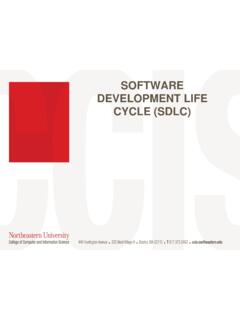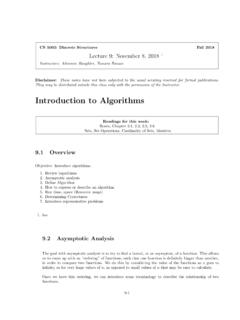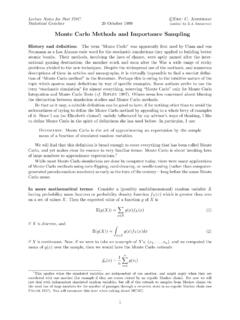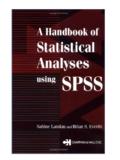Transcription of Tutorial on Support Vector Machine (SVM)
1 Tutorial on Support Vector Machine (SVM) Vikramaditya Jakkula, School of EECS, Washington State University, Pullman 99164. Abstract: In this Tutorial we present a brief introduction to SVM, and we discuss about SVM from published papers, workshop materials & material collected from books and material available online on the World Wide Web. In the beginning we try to define SVM and try to talk as why SVM, with a brief overview of statistical learning theory. The mathematical formulation of SVM is presented, and theory for the implementation of SVM is briefly discussed.
2 Finally some conclusions on SVM and application areas are included. Support Vector Machines (SVMs) are competing with Neural Networks as tools for solving pattern recognition problems. This Tutorial assumes you are familiar with concepts of Linear Algebra, real analysis and also understand the working of neural networks and have some background in AI. Introduction Machine Learning is considered as a subfield of Artificial Intelligence and it is concerned with the development of techniques and methods which enable the computer to learn.
3 In simple terms development of algorithms which enable the Machine to learn and perform tasks and activities. Machine learning overlaps with statistics in many ways. Over the period of time many techniques and methodologies were developed for Machine learning tasks [1]. Support Vector Machine (SVM) was first heard in 1992, introduced by Boser, Guyon, and Vapnik in COLT-92. Support Vector machines (SVMs) are a set of related supervised learning methods used for classification and regression [1]. They belong to a family of generalized linear classifiers.
4 In another terms, Support Vector Machine (SVM) is a classification and regression prediction tool that uses Machine learning theory to maximize predictive accuracy while automatically avoiding over-fit to the data. Support Vector machines can be defined as systems which use hypothesis space of a linear functions in a high dimensional feature space, trained with a learning algorithm from optimization theory that implements a learning bias derived from statistical learning theory. Support Vector Machine was initially popular with the NIPS community and now is an active part of the Machine learning research around the world.
5 SVM becomes famous when, using pixel maps as input; it gives accuracy comparable to sophisticated neural networks with elaborated features in a handwriting recognition task [2]. It is also being used for many applications, such as hand writing analysis, face analysis and so forth, especially for pattern classification and regression based applications. The foundations of Support Vector Machines (SVM) have been developed by Vapnik [3] and gained popularity due to many promising features such as better empirical performance.
6 The formulation uses the Structural Risk Minimization (SRM) principle, which has been shown to be superior, [4], to traditional Empirical Risk Minimization (ERM) principle, used by conventional neural networks. SRM minimizes an upper bound on the expected risk, where as ERM minimizes the error on the training data. It is this difference which equips SVM with a greater ability to generalize, which is the goal in statistical learning. SVMs were developed to solve the classification problem, but recently they have been extended to solve regression problems [5].
7 statistical Learning Theory The statistical learning theory provides a framework for studying the problem of gaining knowledge, making predictions, making decisions from a set of data. In simple terms, it enables the choosing of the hyper plane space such a way that it closely represents the underlying function in the target space [6]. In statistical learning theory the problem of supervised learning is formulated as follows. We are given a set of training data {(x1,y1).. (xl,yl)} in Rn R sampled according to unknown probability distribution P(x,y), and a loss function V(y,f(x)) that measures the error, for a given x, f(x) is "predicted" instead of the actual value y.
8 The problem consists in finding a function f that minimizes the expectation of the error on new data that is, finding a function f that minimizes the expected error: dy d y),P( ))f(V(y,xxx [6] In statistical modeling we would choose a model from the hypothesis space, which is closest (with respect to some error measure) to the underlying function in the target space. More on statistical learning theory can be found on introduction to statistical learning theory [7]. Learning and Generalization Early Machine learning algorithms aimed to learn representations of simple functions .
9 Hence, the goal of learning was to output a hypothesis that performed the correct classification of the training data and early learning algorithms were designed to find such an accurate fit to the data [8]. The ability of a hypothesis to correctly classify data not in the training set is known as its generalization. SVM performs better in term of not over generalization when the neural networks might end up over generalizing easily [11]. Another thing to observe is to find where to make the best trade-off in trading complexity with the number of epochs; the illustration brings to light more information about this.
10 The below illustration is made from the class notes. Figure 1: Number of Epochs Vs Complexity. [8][9][11] Introduction to SVM: Why SVM? Firstly working with neural networks for supervised and unsupervised learning showed good results while used for such learning applications. MLP s uses feed forward and recurrent networks. Multilayer perceptron (MLP) properties include universal approximation of continuous nonlinear functions and include learning with input-output patterns and also involve advanced network architectures with multiple inputs and outputs [10].












